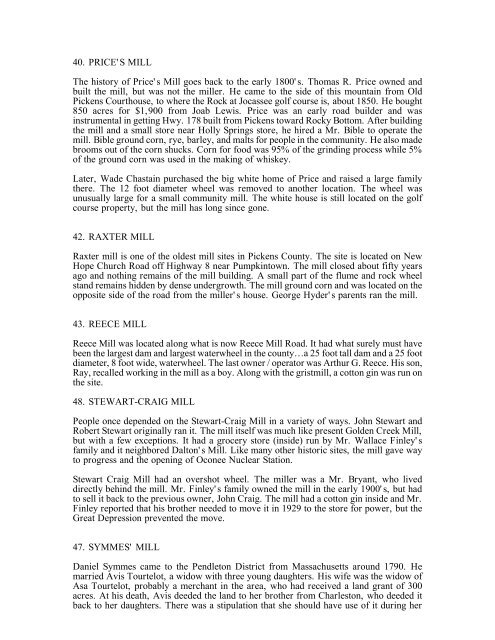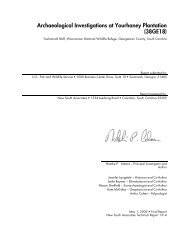Mills in the Upcountry: a Historic Context, and a Summary of a Mill ...
Mills in the Upcountry: a Historic Context, and a Summary of a Mill ...
Mills in the Upcountry: a Historic Context, and a Summary of a Mill ...
Create successful ePaper yourself
Turn your PDF publications into a flip-book with our unique Google optimized e-Paper software.
40. PRICE' S MILL<br />
The history <strong>of</strong> Price' s <strong>Mill</strong> goes back to <strong>the</strong> early 1800' s. Thomas R. Price owned <strong>and</strong><br />
built <strong>the</strong> mill, but was not <strong>the</strong> miller. He came to <strong>the</strong> side <strong>of</strong> this mounta<strong>in</strong> from Old<br />
Pickens Courthouse, to where <strong>the</strong> Rock at Jocassee golf course is, about 1850. He bought<br />
850 acres for $1,900 from Joab Lewis. Price was an early road builder <strong>and</strong> was<br />
<strong>in</strong>strumental <strong>in</strong> gett<strong>in</strong>g Hwy. 178 built from Pickens toward Rocky Bottom. After build<strong>in</strong>g<br />
<strong>the</strong> mill <strong>and</strong> a small store near Holly Spr<strong>in</strong>gs store, he hired a Mr. Bible to operate <strong>the</strong><br />
mill. Bible ground corn, rye, barley, <strong>and</strong> malts for people <strong>in</strong> <strong>the</strong> community. He also made<br />
brooms out <strong>of</strong> <strong>the</strong> corn shucks. Corn for food was 95% <strong>of</strong> <strong>the</strong> gr<strong>in</strong>d<strong>in</strong>g process while 5%<br />
<strong>of</strong> <strong>the</strong> ground corn was used <strong>in</strong> <strong>the</strong> mak<strong>in</strong>g <strong>of</strong> whiskey.<br />
Later, Wade Chasta<strong>in</strong> purchased <strong>the</strong> big white home <strong>of</strong> Price <strong>and</strong> raised a large family<br />
<strong>the</strong>re. The 12 foot diameter wheel was removed to ano<strong>the</strong>r location. The wheel was<br />
unusually large for a small community mill. The white house is still located on <strong>the</strong> golf<br />
course property, but <strong>the</strong> mill has long s<strong>in</strong>ce gone.<br />
42. RAXTER MILL<br />
Raxter mill is one <strong>of</strong> <strong>the</strong> oldest mill sites <strong>in</strong> Pickens County. The site is located on New<br />
Hope Church Road <strong>of</strong>f Highway 8 near Pumpk<strong>in</strong>town. The mill closed about fifty years<br />
ago <strong>and</strong> noth<strong>in</strong>g rema<strong>in</strong>s <strong>of</strong> <strong>the</strong> mill build<strong>in</strong>g. A small part <strong>of</strong> <strong>the</strong> flume <strong>and</strong> rock wheel<br />
st<strong>and</strong> rema<strong>in</strong>s hidden by dense undergrowth. The mill ground corn <strong>and</strong> was located on <strong>the</strong><br />
opposite side <strong>of</strong> <strong>the</strong> road from <strong>the</strong> miller' s house. George Hyder' s parents ran <strong>the</strong> mill.<br />
43. REECE MILL<br />
Reece <strong>Mill</strong> was located along what is now Reece <strong>Mill</strong> Road. It had what surely must have<br />
been <strong>the</strong> largest dam <strong>and</strong> largest waterwheel <strong>in</strong> <strong>the</strong> county…a 25 foot tall dam <strong>and</strong> a 25 foot<br />
diameter, 8 foot wide, waterwheel. The last owner / operator was Arthur G. Reece. His son,<br />
Ray, recalled work<strong>in</strong>g <strong>in</strong> <strong>the</strong> mill as a boy. Along with <strong>the</strong> gristmill, a cotton g<strong>in</strong> was run on<br />
<strong>the</strong> site.<br />
48. STEWART-CRAIG MILL<br />
People once depended on <strong>the</strong> Stewart-Craig <strong>Mill</strong> <strong>in</strong> a variety <strong>of</strong> ways. John Stewart <strong>and</strong><br />
Robert Stewart orig<strong>in</strong>ally ran it. The mill itself was much like present Golden Creek <strong>Mill</strong>,<br />
but with a few exceptions. It had a grocery store (<strong>in</strong>side) run by Mr. Wallace F<strong>in</strong>ley' s<br />
family <strong>and</strong> it neighbored Dalton' s <strong>Mill</strong>. Like many o<strong>the</strong>r historic sites, <strong>the</strong> mill gave way<br />
to progress <strong>and</strong> <strong>the</strong> open<strong>in</strong>g <strong>of</strong> Oconee Nuclear Station.<br />
Stewart Craig <strong>Mill</strong> had an overshot wheel. The miller was a Mr. Bryant, who lived<br />
directly beh<strong>in</strong>d <strong>the</strong> mill. Mr. F<strong>in</strong>ley' s family owned <strong>the</strong> mill <strong>in</strong> <strong>the</strong> early 1900' s, but had<br />
to sell it back to <strong>the</strong> previous owner, John Craig. The mill had a cotton g<strong>in</strong> <strong>in</strong>side <strong>and</strong> Mr.<br />
F<strong>in</strong>ley reported that his bro<strong>the</strong>r needed to move it <strong>in</strong> 1929 to <strong>the</strong> store for power, but <strong>the</strong><br />
Great Depression prevented <strong>the</strong> move.<br />
47. SYMMES' MILL<br />
Daniel Symmes came to <strong>the</strong> Pendleton District from Massachusetts around 1790. He<br />
married Avis Tourtelot, a widow with three young daughters. His wife was <strong>the</strong> widow <strong>of</strong><br />
Asa Tourtelot, probably a merchant <strong>in</strong> <strong>the</strong> area, who had received a l<strong>and</strong> grant <strong>of</strong> 300<br />
acres. At his death, Avis deeded <strong>the</strong> l<strong>and</strong> to her bro<strong>the</strong>r from Charleston, who deeded it<br />
back to her daughters. There was a stipulation that she should have use <strong>of</strong> it dur<strong>in</strong>g her







